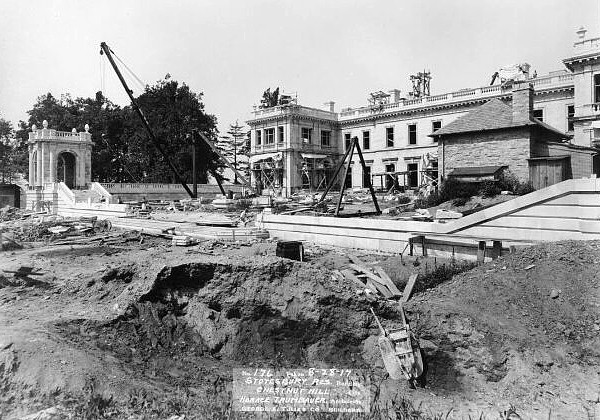
Horace Trumbauer, Whitemarsh Hall (Wyndmoor, PA: under construction, 1917.08.28)
| |

2002.08.28
2003.08.28
Re: closing on Mars
Last night I began to wonder/question when exactly the planet Mars was first named (for) Mars. Moreover, what did/do other (than Western) cultures name the fourth planet of our solar system? According to Encyclopedia Britannica, the Greeks associated the fourth planet with Ares (also a god of war) supposedly because of its red (i.e., danger) color.
When Mars is in opposition, like now, it is the fourth brightest heavenly body (relative to Earth viewing), being surpassed only by the sun, the moon, and the planet Venus. When Mars is not in opposition, the planet Jupiter is the fourth brightest heavenly object (relative to Earth viewing). Perhaps the ancients (at least the Greeks and the Romans) saw this periodic exchange of 'power' between Jupiter and Mars as indicative of the periodic power of war over even the most high. Fortunately, love, i.e. Venus, is never outshone by either Mars or Jupiter.
| |
2003.08.28 12:50
Re: FW: Evolutionary theory and architecture
Regarding "evolutionary theory and architecture," there are some precedents that should be considered. For example, the works of J. N. L. Durand and Seroux 'Agincourt, both from the early 19th century, offer 'histories' of (art and) architecture that are (up until then) unique in their application, indeed a more 'evolutionary' approach towards classification.
Durand, in his Recueil et Parallele des Edifices de tout Genre - Anciens et Moderns, specifically categorizes the history of architecture (including non-Western examples) by type, but he also presents all examples drawn at the same scale, thus simultaneously rendering a history of architecture via comparative size.
Seroux 'Agincourt, in his Histoire de l'art par les monuments depuis sa decadence au IV siecle jusqu'a son renouvellement au XVI (The History of Art through its Monuments from Its Decadence in the Fourth Century to Its Renewal in the Sixteenth), attempts to document how (mostly Western) architectural style became decadent between the Roman Empire and the Renaissance, as if displaying all the mutations (Western) architecture went through until it again became 'classical'.
| |
13082801 House 10: Museum at Logan Circle IQ5 in register with House 10: Museum in Campo Rovine plans 2197i08 b c
13082802 House 10: Museum at Calder Museum site in register with House 10: Museum in Campo Rovine plans 2197i09
13082803 House 10: Museum at Eakins Oval in register with House 10: Museum in Campo Rovine plans 2197i10
13082804 [virtual] Museum Museum superimposed plans 2428i01
13082805 [virtual] Museum Museum schematic model 2428i02
14082801 Mateo Arquitectura Viviendas en Toulouse France
16082801 OFFICE Der Bau Brussels
17082801 Parthenon columns Villa Stein de Monzie Wall House 2 Museum for Nordrhein Westfalen perspectives 2066i07
17082802 Parthenon columns model Acropolis plan image 2066i08
17082803 Parthenon columns Villa Stein de Monzie models Acropolis plan image 2066i09
18082801 Tower of Shadows plan elevation Quondam group elevations 2186i10
18082802 Gateway Arch plan elevations model image 216ii01
18082803 Arch of Constantine Gateway Arch elevation 216ii02
19082801 Great Pyramid Parthenon Temple of Horus Pantheon Sts. Sergius and Bacchus Beauvais Cathedral Santa Maria della Grazie St. Peter's Basilica San Giorgio Maggiore Il Redentore sections 2060i30
19082802 Sant'Andrea al Quirinale St. Genevieve/Panthéon Altes Museum sections 2094i02
19082803 Surface Building 1 elevations roof plans 2470i24
20082801 Maze House working data model work images 229li04
|

